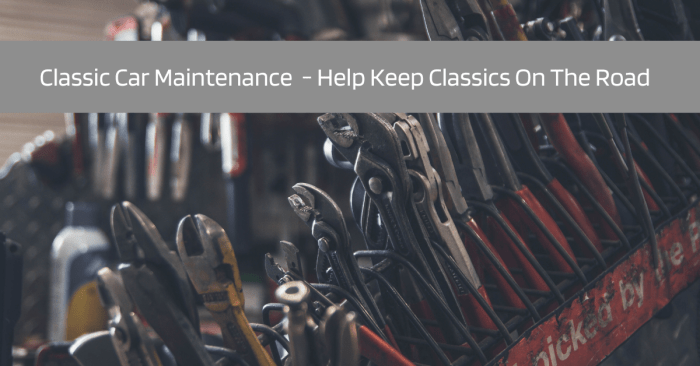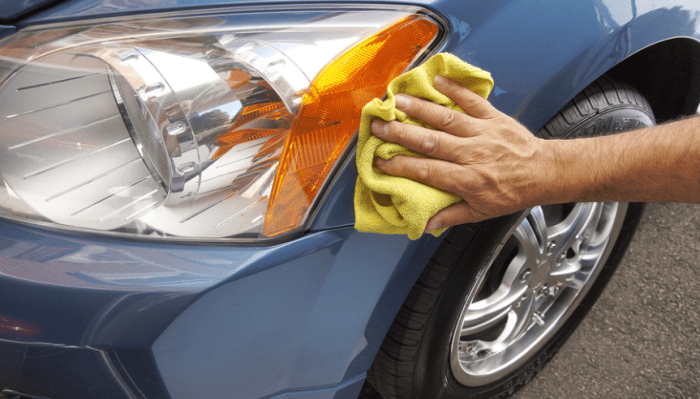Classic car maintenance tips: Dive into the realm of classic car upkeep, where passion and preservation intertwine. Discover the secrets to keeping your vintage beauty in pristine condition, ensuring its timeless allure for generations to come.
From meticulous maintenance schedules to expert fluid management, electrical system troubleshooting, and interior restoration, this guide will equip you with the knowledge and techniques to safeguard your classic car’s legacy.
Regular Maintenance Schedule

Regular maintenance is crucial for preserving the longevity and performance of classic cars. By adhering to a comprehensive maintenance schedule, owners can prevent costly repairs, enhance driving experience, and extend the lifespan of their beloved vehicles.
A detailed maintenance schedule should encompass the following tasks:
Oil Changes
- Regular oil changes are essential for lubricating engine components and removing contaminants. Frequency varies depending on the vehicle’s age, mileage, and driving conditions, but generally, oil changes should be performed every 3,000 to 5,000 miles.
Tire Rotations
- Tire rotations ensure even wear, improve handling, and extend tire life. Rotations should be performed every 5,000 to 7,500 miles, or as recommended by the vehicle’s manufacturer.
Brake Inspections
- Brake inspections are vital for ensuring safe operation. Regular inspections should include checking brake pads, rotors, and fluid levels. Replacements or repairs should be made as needed.
Benefits of following a regular maintenance schedule include:
- Extended lifespan: Regular maintenance helps prevent premature wear and tear, prolonging the vehicle’s lifespan.
- Improved performance: Proper maintenance ensures optimal engine performance, fuel efficiency, and handling.
- Reduced repair costs: By identifying and addressing potential issues early on, regular maintenance can prevent costly repairs in the future.
Fluid Maintenance: Classic Car Maintenance Tips
Classic cars rely on various fluids to operate smoothly and efficiently. These fluids include engine oil, transmission fluid, coolant, brake fluid, and power steering fluid. Regular maintenance and fluid changes are crucial to prevent leaks, damage, and costly repairs.
Engine Oil
Engine oil lubricates moving parts within the engine, reducing friction and wear. It also helps dissipate heat and remove contaminants. Classic cars typically require specific oil types and viscosities, depending on the engine design and age. Check your owner’s manual for the recommended oil type and change it at regular intervals.
Transmission Fluid
Transmission fluid ensures smooth gear shifting and power transfer in manual and automatic transmissions. It lubricates gears, clutches, and bearings. Like engine oil, transmission fluid should be checked and changed according to the manufacturer’s recommendations. Neglecting fluid changes can lead to transmission damage.
Coolant, Classic car maintenance tips
Coolant regulates engine temperature by absorbing heat and dissipating it through the radiator. It also prevents corrosion and freezing in the cooling system. Classic cars often have specific coolant requirements, such as a mixture of water and antifreeze. Regular coolant flushes and replacements are necessary to maintain cooling efficiency and prevent overheating.
Electrical System Maintenance

Classic cars are renowned for their unique electrical systems, which differ significantly from modern vehicles. Understanding and maintaining these systems is crucial for ensuring optimal performance and preventing potential issues.Common electrical problems in classic cars include faulty wiring, weak batteries, and flickering lights.
Troubleshooting and repairing these issues requires a systematic approach and a thorough understanding of the electrical components involved. Upgrading electrical components, such as alternators and starters, can also enhance performance and reliability.
Battery Maintenance
Batteries are the heart of a classic car’s electrical system. Regular maintenance, including cleaning terminals, checking fluid levels, and testing voltage, is essential for ensuring optimal battery life. Weak batteries can lead to starting problems, electrical system malfunctions, and even damage to sensitive components.
Wiring Inspection and Repair
Wiring harnesses in classic cars are prone to aging and damage, leading to electrical problems. Regular inspection and repair of wiring is crucial for maintaining electrical integrity. Look for signs of fraying, corrosion, or loose connections, and replace or repair damaged wires promptly.
Electrical Component Upgrading
Upgrading electrical components, such as alternators and starters, can improve performance and reliability in classic cars. Modern alternators provide higher charging capacity, while high-torque starters ensure reliable engine starts, especially in cold weather or after extended periods of storage.
Body and Paint Care
The body and paint of a classic car are its most visible features, and they play a major role in determining the car’s overall value and appeal. It is important to take proper care of the body and paint to protect them from damage and keep the car looking its best.
Types of Paint and Finishes
There are many different types of paint and finishes that can be used on classic cars. The most common type of paint is acrylic lacquer, which is a durable and easy-to-apply finish. Other types of paint include enamel, urethane, and waterborne paint.
The type of finish that is used on a classic car will depend on the desired look and the budget. A high-gloss finish will give the car a shiny, mirror-like appearance, while a matte finish will give the car a more subdued look.
A clear coat can be applied over the paint to protect it from UV rays and other damage.
Notice Classic car insurance quotes for recommendations and other broad suggestions.
Protecting the Paint
It is important to protect the paint on a classic car from fading, scratches, and rust. Fading can be caused by UV rays from the sun, while scratches can be caused by road debris or other objects. Rust can be caused by moisture and salt, which can penetrate the paint and damage the metal underneath.
There are a number of things that can be done to protect the paint on a classic car. These include:
- Washing the car regularly with a mild soap and water solution
- Waxing the car every few months to create a protective barrier
- Polishing the car to remove scratches and restore the shine
- Applying a clear coat to protect the paint from UV rays and other damage
Washing, Waxing, and Polishing
Washing, waxing, and polishing are essential steps for maintaining the appearance of a classic car. Washing the car removes dirt and debris that can damage the paint, while waxing and polishing protect the paint from further damage and restore its shine.
To wash a classic car, use a mild soap and water solution. Avoid using harsh detergents or abrasive cleaners, as these can damage the paint. Rinse the car thoroughly with clean water after washing, and then dry it with a soft cloth.
To wax a classic car, apply a thin coat of wax to the paint using a soft cloth. Allow the wax to dry for a few minutes, and then buff it off with a clean cloth. Waxing the car will help to protect the paint from UV rays and other damage.
To polish a classic car, use a polish that is specifically designed for automotive paint. Apply the polish to the paint using a soft cloth, and then buff it off with a clean cloth. Polishing the car will help to remove scratches and restore the shine.
Interior Maintenance

Maintaining the interior of a classic car is essential for preserving its value and appeal. Classic car interiors are often made from a variety of materials, including leather, vinyl, and fabric, each with its own unique cleaning and care requirements.
Cleaning and Protecting Interior Surfaces
Regular cleaning is crucial for preventing wear and tear on interior surfaces. Leather seats should be cleaned with a mild leather cleaner and conditioner, while vinyl seats can be cleaned with a vinyl cleaner and protectant. Fabric seats should be vacuumed regularly and spot-cleaned with a mild upholstery cleaner.
You also can understand valuable knowledge by exploring How to buy a classic car.
Repairing and Restoring Damaged Interior Components
Over time, interior components may become damaged or worn. Small tears in leather or vinyl seats can be repaired with a leather or vinyl repair kit. Larger tears may require professional repair. Fabric seats can be patched or reupholstered if necessary.
Dashboard and Trim Care
The dashboard and trim are also important components of the interior. To clean the dashboard, use a mild cleaner and a soft cloth. Avoid using harsh chemicals or abrasive cleaners, as these can damage the finish. Trim can be cleaned with a mild soap and water solution.
Performance Upgrades
Enhance the performance of your classic car with upgrades that boost its engine, suspension, and brakes. These modifications not only improve driving dynamics but also enhance the overall driving experience.
Before embarking on any performance upgrades, consider the compatibility with your specific classic car model and consult with experienced mechanics or enthusiasts.
Engine Modifications
Engine modifications are a popular way to increase power and torque. Options include:
- Cold Air Intake:Improves airflow and reduces engine temperature, resulting in increased horsepower.
- Performance Exhaust System:Reduces backpressure, allowing for better exhaust flow and improved performance.
- Cylinder Head Porting and Polishing:Smooths and enlarges the intake and exhaust ports, optimizing airflow and increasing engine efficiency.
- Camshaft Upgrades:Alters valve timing, duration, and lift, enhancing engine breathing and performance.
- Forced Induction (Turbochargers or Superchargers):Adds forced air into the engine, significantly increasing power and torque.
Suspension Enhancements
Suspension upgrades improve handling, stability, and ride comfort:
- Upgraded Springs and Shocks:Stiffer springs and performance shocks reduce body roll, improve cornering, and enhance ride quality.
- Sway Bars (Anti-Roll Bars):Reduce body lean during cornering, improving handling and stability.
- Lowering Springs or Coilovers:Lowers the car’s ride height, reducing aerodynamic drag and improving handling.
- Strut Tower Braces:Reinforce the front suspension towers, increasing rigidity and improving handling.
Brake Upgrades
Brake upgrades enhance stopping power and safety:
- Larger Brake Rotors:Provide increased surface area for improved heat dissipation and braking power.
- Performance Brake Pads:Offer higher friction coefficients, reducing stopping distances and improving overall braking performance.
- Upgraded Brake Lines:Replace stock rubber brake lines with stainless steel or braided lines, reducing expansion and improving brake feel.
- Brake Master Cylinder Upgrade:Increases the pressure in the brake system, resulting in more responsive and effective braking.
Last Point
Maintaining a classic car is a labor of love, a journey that transcends mere mechanics and delves into the realm of passion and heritage. By embracing these essential tips, you become the guardian of your automotive treasure, ensuring its enduring legacy and the preservation of its timeless beauty.